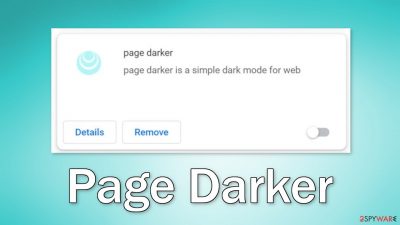Page Darker browser extension (fake) - Free Guide
Page Darker browser extension Removal Guide
What is Page Darker browser extension?
Page Darker browser extension claims to provide dark mode for websites but does not deliver

Page Darker browser extension was classified as a browser hijacker because it does not perform what it promises and starts messing up the settings. It is promoted as a plugin that can turn web pages into dark mode. In reality, this add-on starts changing the main settings, like the homepage, new tab address, and search engine. It can also display pop-ups, banners, and cause redirects.
The creators of the plugin do not care about user privacy or security so they can use rogue advertising networks that place ads leading to dangerous websites that can trick people into downloading PUPs (potentially unwanted programs),[1] and even malware. Usually, this includes free software deals, updates, and tech support scams. Users should remove the intruder as soon as possible, especially if there are children using the affected machine as they can be exposed to inappropriate content.
| NAME | Page Darker |
| TYPE | Browser hijacker; potentially unwanted program |
| SYMPTOMS | The settings of the browser get changed, like the homepage, new tab address, and search engine; redirects to suspicious pages and commercials injected in websites |
| DISTRIBUTION | Shady websites, deceptive ads, redirects, freeware installations |
| DANGERS | The application can change all data on its pages and read users' browsing history |
| ELIMINATION | Go to your browser settings to remove the extension responsible for unwanted behavior |
| FURTHER STEPS | Use a repair tool FortectIntego to fix any damage left after the intruder and to optimize the machine |
Distribution techniques
Browser hijackers are often disguised as “handy” tools that can improve users' browsing experience. They rarely deliver on their promises. Page Darker, in particular, was found to be distributed on the chrome web store. Unfortunately, sometimes hijackers sneak through the extensive review process and get listed on digital marketplaces.
Even though we always recommend downloading only from official web stores, when choosing an extension, it is still important to do your research – read the reviews, look at the ratings, and the number of users. It is best to use plugins that have plenty of feedback about them. You will often find that if you enter the name of a hijacker into the search, not many related results will pop up.
To avoid hijacking you should also avoid surfing through shady sites, clicking on random links, and downloading apps that you see in ads. Put in the wok, and make sure the software is safe to install before proceeding. Often, hijackers also get added by PUPs that sneak into the system through freeware distribution sites. They monetize user activity and generate revenue from pay-per-click[2] ads and data gathering.
Depending on the infection method, different removal techniques may apply. For some users, simply removing the plugin from the browser does the trick, and some others have to do some exploring in their machine looking for an adware[3] infection that could be responsible for the changes.

Remove the plugin
You should first try to locate the extension responsible for the changes in your browser settings. Look for Page Darker in the list by following our guide and move on to the next step:
Google Chrome
- Open Google Chrome, click on the Menu (three vertical dots at the top-right corner) and select More tools > Extensions.
- In the newly opened window, you will see all the installed extensions. Uninstall all the suspicious plugins that might be related to the unwanted program by clicking Remove.
![Remove extensions from Chrome Remove extensions from Chrome]()
MS Edge:
- Select Menu (three horizontal dots at the top-right of the browser window) and pick Extensions.
- From the list, pick the extension and click on the Gear icon.
- Click on Uninstall at the bottom.
![Remove extensions from Edge Remove extensions from Edge]()
MS Edge (Chromium)
- Open Edge and click select Settings > Extensions.
- Delete unwanted extensions by clicking Remove.
![Remove extensions from Chromium Edge Remove extensions from Chromium Edge]()
Mozilla Firefox
- Open Mozilla Firefox browser and click on the Menu (three horizontal lines at the top-right of the window).
- Select Add-ons.
- In here, select the unwanted plugin and click Remove.
![Remove extensions from Firefox Remove extensions from Firefox]()
Safari
- Click Safari > Preferences…
- In the new window, pick Extensions.
- Select the unwanted extension and select Uninstall.
![Remove extensions from Safari Remove extensions from Safari]()
Get rid of cookies and cache
Browser extensions can follow your activity with various tracking technologies, like cookies. These small data files can store your IP address,[4] geolocation, websites you visit, links you click on, and things you purchase online. Although cookies are not inherently bad, if they end up in the wrong hands, your information can be used sold to rogue advertising networks and other third parties.
That is why security experts recommend clearing cookies and cache regularly. That can become a very annoying process so you can use a maintenance tool like FortectIntego that can do it automatically. Besides, this software can fix various system errors, corrupted files, and registry issues which is especially helpful after virus infections.
Check your system for adware
The first method may not have gotten rid of the symptoms completely. That is because there might be a PUA hiding in your system. The application can keep messing up your browser settings until you completely remove it from your device. Identifying the program responsible for the changed settings might be difficult if you have never done this before.
The program could be disguised as antivirus, system optimizer, or media player because they are most often made to look like a “handy” tool. PUPs are usually installed from freeware distribution sites. These platforms include additional programs in the installers in the hopes that most people will not notice. Unfortunately, that is exactly what happens most of the time.
If you want to avoid this happening in the future, you should always:
- Choose the “Custom” or “Advanced” installation method
- Read the Privacy Policy and Terms of Use
- Inspect the file list and uncheck the boxes next to any unrelated programs that you do not need
Suppose you do not want to risk deleting the wrong files. In that case, we suggest using SpyHunter 5Combo Cleaner or Malwarebytes professional security tools that will scan your machine, eliminate it, and prevent such infections in the future by giving you a warning before a PUP can make any changes. If you prefer manual removal because you know what to do, we have instructions for Windows and Mac machines.
Keep in mind that manual removal can sometimes result in the renewal of the infection as users fail to eliminate all the related files and entries.
Windows 10/8:
- Enter Control Panel into Windows search box and hit Enter or click on the search result.
- Under Programs, select Uninstall a program.
![Uninstall from Windows 1 Uninstall from Windows 1]()
- From the list, find the entry of the suspicious program.
- Right-click on the application and select Uninstall.
- If User Account Control shows up, click Yes.
- Wait till the uninstallation process is complete and click OK.
![Uninstall from Windows 2 Uninstall from Windows 2]()
Windows 7/XP:
- Click on Windows Start > Control Panel located on the right pane (if you are a Windows XP user, click on Add/Remove Programs).
- In Control Panel, select Programs > Uninstall a program.
![Uninstall from Windows 7/XP Uninstall from Windows 7/XP]()
- Pick the unwanted application by clicking on it once.
- At the top, click Uninstall/Change.
- In the confirmation prompt, pick Yes.
- Click OK once the removal process is finished.
Mac:
- From the menu bar, select Go > Applications.
- In the Applications folder, look for all related entries.
- Click on the app and drag it to Trash (or right-click and pick Move to Trash)
![Uninstall from Mac 1 Uninstall from Mac 1]()
To fully remove an unwanted app, you need to access Application Support, LaunchAgents, and LaunchDaemons folders and delete relevant files:
- Select Go > Go to Folder.
- Enter /Library/Application Support and click Go or press Enter.
- In the Application Support folder, look for any dubious entries and then delete them.
- Now enter /Library/LaunchAgents and /Library/LaunchDaemons folders the same way and terminate all the related .plist files.
![Uninstall from Mac 2 Uninstall from Mac 2]()
How to prevent from getting browser hijacker
Do not let government spy on you
The government has many issues in regards to tracking users' data and spying on citizens, so you should take this into consideration and learn more about shady information gathering practices. Avoid any unwanted government tracking or spying by going totally anonymous on the internet.
You can choose a different location when you go online and access any material you want without particular content restrictions. You can easily enjoy internet connection without any risks of being hacked by using Private Internet Access VPN.
Control the information that can be accessed by government any other unwanted party and surf online without being spied on. Even if you are not involved in illegal activities or trust your selection of services, platforms, be suspicious for your own security and take precautionary measures by using the VPN service.
Backup files for the later use, in case of the malware attack
Computer users can suffer from data losses due to cyber infections or their own faulty doings. Ransomware can encrypt and hold files hostage, while unforeseen power cuts might cause a loss of important documents. If you have proper up-to-date backups, you can easily recover after such an incident and get back to work. It is also equally important to update backups on a regular basis so that the newest information remains intact – you can set this process to be performed automatically.
When you have the previous version of every important document or project you can avoid frustration and breakdowns. It comes in handy when malware strikes out of nowhere. Use Data Recovery Pro for the data restoration process.
- ^ Chris Hoffman. PUPs Explained: What is a “Potentially Unwanted Program”?. HowToGeek. Technology Magazine.
- ^ What Is PPC? Learn the Basics of Pay-Per-Click (PPC) Marketing. WordStream. Advertising Solutions.
- ^ What is Adware? – Definition and Explanation. Kaspersky. Home Secuirty.
- ^ IP address. Wikipedia, the free encyclopedia.










